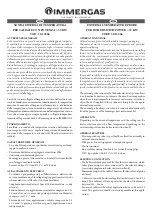
Matrix Installation and Operation Instructions
31
Boiler System Plumbing
Feed Water Pressure Regulator
(Factory Supplied)
:
The Matrix operates as a boiler to provide heat, thus it
must be installed and operated as such. A 12-15 PSI pressure regulator is provided with the Matrix and must
be field installed as per the installation instructions. Note: Local authorities may require the installation of a
certified “back-flow preventer” immediately before the pressure regulator.
Circulating Pump
(Factory Supplied)
:
The Matrix has a built-in circulator to pump water from the boiler to
either the internal forced-air heating coil or the internal domestic coil (brazed plate heat exchanger). An
external circulator is only required if the Matrix is also being used to supply heat to a hydronic
heating system,
the external circulator must be sized for the requirements of the hydronic heating system.
Air Removal:
Boilers are designed to operate with airless water in the system. The Matrix design allows for the
evacuation of air from the internal plumbing. For installations in conjunction with a hydronic heating system
an air removal device, such as an air scoop or micro-bubbler, designed to remove the air from the water as it
flows through the system, must be installed
Follow the installation instructions included with the air removal device when placing it
in the system; air removal devices generally work better when placed higher in the
system. Always locate air removal devices in areas of the system that have a guaranteed
positive pressure, e.g., in close proximity to the water fill and expansion tank.
Expansion Tank
(Factory Supplied)
:
The Matrix comes with a built-in expansion tank that is sized to handle the
volume of water in the Matrix unit. An external expansion tank must be field sized, supplied and installed for
Matrix units installed in systems with hydronic heat.
Ensure the expansion tank cannot become isolated from the boiler anytime the system is
operating. Failure to follow these instructions may result in discharge of the Pressure
Relief Valve may result in property damage or personal injury.
Mixing Controls –
During “forced-air” heating demands, the Matrix will operated at a constantly varying boiler
water temperature; this temperature may at times exceed the maximum allowable temperature for certain types
of hydronic heating systems (i.e. infloor heating). Therefore, for low temperature heating applications, mixing
controls, such as a thermostatic mixing valve or injection system, must be used to limit the temperature of the
water entering the heating system.
Failure to employ mixing controls where necessary, may lead to property damage caused
by excessive heat.
Figures 10-3 to 10-5 illustrate typical piping systems. These piping schematics do not
illustrate all of the required concepts and components required to have a proper
installation. Concepts not shown include: prevention of thermal-siphoning (heat traps),
isolation valves, drain and purge valves, etc. It is the responsibility of the installing
contractor and system designer to determine which system best meets the need of the
installation and to consider all aspects of a proper system design. Contractor
modifications to these instructions may be required, based upon existing piping and
system design.
















































